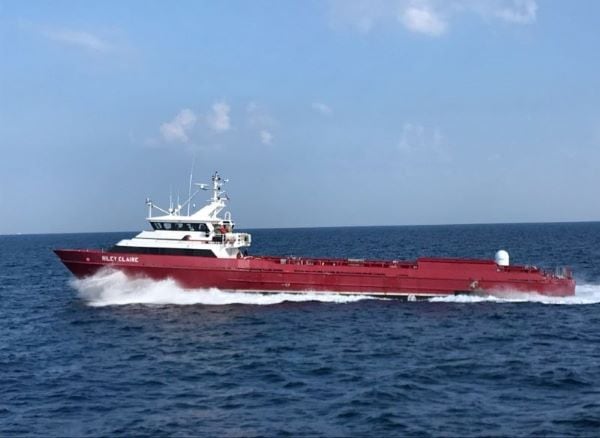The U.S. Navy wants $464 million for unmanned surface vessels, but Congress is not on the same page.
Legislators have so far declined to fully fund the massive investment into research and development for large and medium unmanned surface vessels as they work through the annual defense bill, citing the request as “excessive procurement ahead of satisfactory testing.”
Among other things, that budget request would give the Navy $239 million to purchase two Overlord large unmanned surface vehicle (LUSV) prototypes for testing.
While the Senate Armed Services Committee has declined to authorize any of the $464 million request, the House Armed Services Committee agreed to authorize just $270 million of that request — specifically cutting funding for the two LUSVs. Instead, the House version would provide the Navy $45 million to convert a Spearhead-class expeditionary fast transport ship into a LUSV for further testing.
In a report on the bill issued by the Senate Armed Services Committee, lawmakers argued that the Navy already has the LUSVs that can fill the Strategic Capabilities Office’s needs in this area.
But perhaps more importantly, the committee members do not seem convinced that LUSVs are ready for prime time.
“The committee remains concerned that the budget request’s concurrent approach to LUSV design, technology development, and integration as well as a limited understanding of the LUSV concept of employment, requirements, and reliability for envisioned missions pose excessive acquisition risk for additional LUSV procurement in fiscal year 2021,” the report reads. “The committee is also concerned by the unclear policy implications of LUSVs, including ill-defined international unmanned surface vessel standards and the legal status of armed or potentially armed LUSVs.”
Furthermore, legislators remain unconvinced that the current unmanned vessels can hold up to the physical environment of extended operations at sea. While the Navy requires its unmanned platforms to be able to operate continuously at sea for 30 days without maintenance or repairs, the committee report notes the Strategic Capabilities Office’s prototypes have only demonstrated two to three days of continuous operation.
The Senate version of the bill would require the Navy to formally qualify two main engines and electrical generators — including successfully demonstrating 30 days of continuous operations at sea — before Milestone B approval is granted.
An industry group hit back July 9.
In a letter to leaders of the Senate and House Armed Services Committees, the Association for Unmanned Vehicle Systems International called on legislators to fully fund the Navy’s fiscal 2021 request.
“It is imperative that Congress continues to fund the research and development (R&D) efforts included in the Navy’s FY21 budget request,” wrote President and CEO Brian Wynne. “Failing to do so will disrupt the significant investment industry has made in unmanned systems over the last several years. The severe reduction in funding being considered in the FY21 NDAA would eliminate jobs, drive many small companies out of business, and cause larger companies to shift their R&D investments to more stable opportunities”
The committee report argues that its requirements do not delay these programs, but in fact will enable the delivery of unmanned surface vehicles faster by ensuring they are “capable, reliable and sustainable.”
In the meantime, the Navy has moved forward with its unmanned surface vehicle efforts.
On July 13, the Navy awarded L3Harris $35 million to develop a medium unmanned surface vehicle prototype, with an option to buy eight more later on. If all options are exercised, the contract could be worth up to $294 million.
“The award of Medium USV is the culmination of a great dialogue with industry to right-size the requirements for a capable, reliable, and affordable unmanned surface vehicle that will employ a variety of modular payloads,” said Capt. Pete Small, program manager of Unmanned Maritime Systems within the Unmanned and Small Combatants Program Executive Office. “Leveraging new rapid prototyping authorities and mature commercial technology will allow us to quickly deliver a capable prototype to the Surface Development Squadron to conduct experimentation and learning in support of the Navy’s plans for a future fleet incorporating unmanned vessels.”
The prototype is expected to be delivered in fiscal 2023. However, the Navy press release announcing the award notes that funding for future MUSV prototypes is uncertain. While the Navy has asked for additional fiscal 2021 funding for a second MUSV prototype in fiscal 2023, that acquisition strategy is yet to be determined.
Nathan Strout covers space, unmanned and intelligence systems for C4ISRNET.








